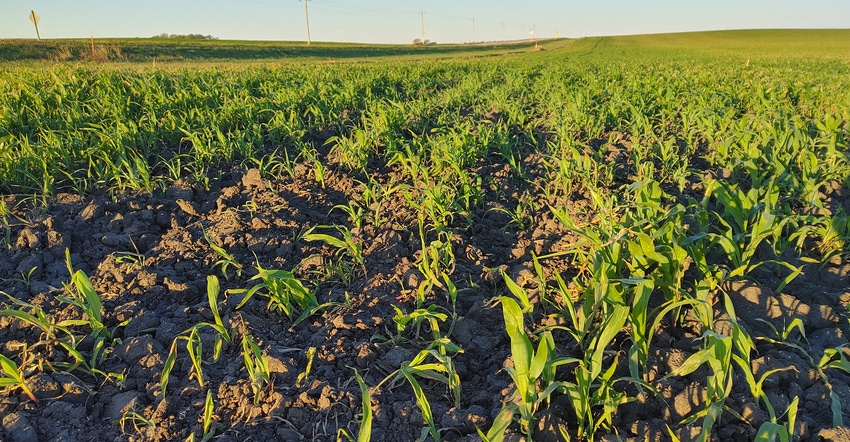February 18, 2021

While much of the initial sting of the derecho has worn off, farmers will be feeling its effects for some time. One challenge for 2021 is the presence of large populations of volunteer corn in derecho-affected fields. While volunteer corn is a common issue, the populations in fields this year likely will be magnitudes larger than in a typical year.
Fields left unharvested in the fall had well over 10 million corn kernels added to the soil. Even if only a fraction of these seed germinate, farmers will face volunteer corn populations far exceeding those necessary to cause yield loss. Some fields that were able to be harvested after the derecho may have little volunteer corn if harvest went well, while others may have large or variable populations depending on direction and difficulty of harvest.
Populations of volunteer corn as low as a few thousand plants per acre (one plant per 3.5 row feet) can cause significant yield loss in corn and soybean; we expect populations to far exceed this in fields damaged by the derecho. Beyond yield loss, volunteer corn may be an attractive host for insect pests like black cutworm, true armyworm and corn rootworm. Preparation and timely in-season management will minimize the headaches caused by the derecho this season.
The herbicide tolerance trait package of the 2020 corn hybrid affects available control strategies for 2021. Several herbicides are effective on volunteer corn in-season: glyphosate, glufosinate, or ACCase inhibiting herbicides (Group 1) like clethodim, fluazifop and quizalofop. Table 1 demonstrates the limited opportunity to return to corn in 2021, as the herbicides available for in-season volunteer corn control are dramatically limited by the trait package of corn grown last season.

Table 1. In-season corn herbicide options for control of volunteer corn; a check mark signifies an effective control option, while an 'X' signifies an ineffective option.
Managing volunteer corn will be easiest when rotating to soybeans due to the lack of in-season herbicide options available to control volunteer corn in corn. While glufosinate is an effective option to manage some volunteer corn, many hybrids contain both the Roundup and Liberty tolerance traits, leaving Group 1 herbicides, and thus rotation to soybeans, as the only effective option for control.
The one caveat to this is Enlist-traited corn. Enlist corn has tolerance to “fop” herbicides like quizalofop (Assure II); however, availability of Enlist hybrids is likely limited for 2021.
Several best management practices will help herbicides work as effectively as possible to control volunteer corn. Applicators should treat volunteer corn when it is less than 12 inches tall, making sure to follow label instructions for appropriate adjuvants and rate.
Several broadleaf herbicides used postemergence in soybean are known for causing antagonism with Group 1 herbicides. Using rates at the high end of the labeled range will improve reduce antagonism and improve control consistency. An option to minimize concerns with antagonism is to separate the applications of Group 1 herbicides from the broadleaf herbicides by applying the Group 1 product at least a day ahead or seven days after the broadleaf herbicides. Most people feel adjusting rates is a better option than an extra pass.
While volunteer corn is typically a non-issue in crop fields, it will be a significant weed problem this year. Careful evaluation of 2020 corn hybrid herbicide traits, herbicide options and best application practices for this season will reduce the impact of last year's derecho on this year's crop.
Anderson is an Iowa State University Extension field agronomist.
About the Author(s)
You May Also Like






